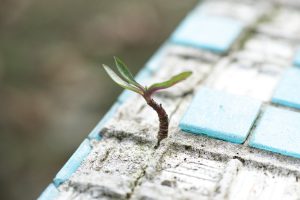Bearings
Giving Up, Giving In, Giving Hope
Rethinking How We Do Lent
By Elizabeth Drescher
March 2019 Issue

As we begin the Lenten season in our various ways across the church, Bearings contributors have been mulling what the traditions of the seasons mean in these times—especially the practice of giving up something of significance to experience a wee bit, or at least express, an understanding of the sacrifice to which the season orients us. But like so many things in our spiritual lives, the practice can become dulled, routinized, a hollow pantomime of what it might once have meant. How do we approach the holiest season of the Christian calendar with a spirit that moves us beyond mere gestures of “sacrifice,” beyond a vacant giving in to habitual practices, toward action that generate hope precisely because they are more than symbolic?
For Diane Bowers, care of the earth, for instance, calls on giving up romantic notions of "the wonder of creation" now at risk to attend to the real, concrete suffering that defines the practical morality of care for the earth. Less awe-inspiring coastlines vaguely threatened by climate change; more tortured hens in the factory farming system or plastic coffee pods floating in islands of oceanic trash. Diane's "Playing Chicken with Care for the Earth" challenges us to reconceive popular notions of awe and wonder that might—but only just might—inspire concrete action to fend off looming planetary extinction by attending to our conflicted, contradictory human nature as "both sinners and saints." Calling on medieval and modern theological powerhouses, she argues that, "Tillich reminds us that those amended actions are still not perfectly ethical, and Luther reminds us that we won’t reach perfection in this life, but we can still say that they are undeniably better." We have to keep at it. Even when it's not pretty.
Jamye Wooten, likewise, refuses to look away from hard realities. In his featured essay, "What's in Your Hand: An Asset-Based Approach to Ministry," Wooten moves beyond reflection on our individual human nature and where it might lead us in terms of care for those in need in the communities around us. "I am a big believer in the collective," he says, describing a network of collaborative, religious-civic projects in his Baltimore community that give up any pretense that one, inspired charismatic leader, one wonder-filled do-gooder, can make it all better. "Individualism will not save us. Collaboration, cooperation, and the sharing of resources — time, talent and treasure — is a must. Only then will it be the case that there will not be a needy person among us — or at least that's what the first followers of Christ believed," he insists as he unveils a new collaborative venture in Greater Baltimore, #CLLCTIVLY, which begins with mapping local assets and resources neighborhood by neighborhood.
 For his part, in "Getting into the Weeds" commentator Jason Hines argues that giving up to give hope calls on churches to refuse the hypocrisy of political disengagement. He refuses any separation of church and state that allows ministry leaders to give up on the charge of actively educating and advocating on the issues that most impact those in their immediate communities and in the world around them. The church, Hines argues, is not meant to separate itself from the real, concrete concerns of the world, but rather to bring the active, moral commitments of Christian faith into the world.
For his part, in "Getting into the Weeds" commentator Jason Hines argues that giving up to give hope calls on churches to refuse the hypocrisy of political disengagement. He refuses any separation of church and state that allows ministry leaders to give up on the charge of actively educating and advocating on the issues that most impact those in their immediate communities and in the world around them. The church, Hines argues, is not meant to separate itself from the real, concrete concerns of the world, but rather to bring the active, moral commitments of Christian faith into the world.
These are all challenging, even discomforting pieces for Lenten reflection. They are tempered, though, by the imagistic explorations of artist DeAnne Parks, whose biblical visions and explorations grace churches and other spiritual centers throughout the Midwest. But this creativity is not easy action, either. In "Art Speaks," DeAnne explains of her artistic spiritual process, “I create chaos on the canvas, turning it and letting the paint drip ...,” hoping ultimately that “people will allow their hearts, minds and spirits to be opened so they might hear, see and feel in a new way.”
We’ve added to these stirring Lenten offerings a reach back into our archives for a Mark Collin’s compelling, “Giving Up for Lent … or Maybe Not.” We trust you’ll find all of this rich fodder for a season that asks us to consider the meaning and practice of loving sacrifice in our own lives, in our own communities, in the world we share.
Photo Credits:
Featured Image: Kristel Hayes, "Butterfly Graffiti" (October 29, 2018). Via Unsplash. CC 2.0 license.
Body image #1: Engin Akyurt, "Green Leafed Plant on Sand" (ND). Via Pexels. CC 2.0 license.
Body image #2: Maret Hosemann, "Gray Metal Mailbox" (February 22, 2016). Via Pixabay.

